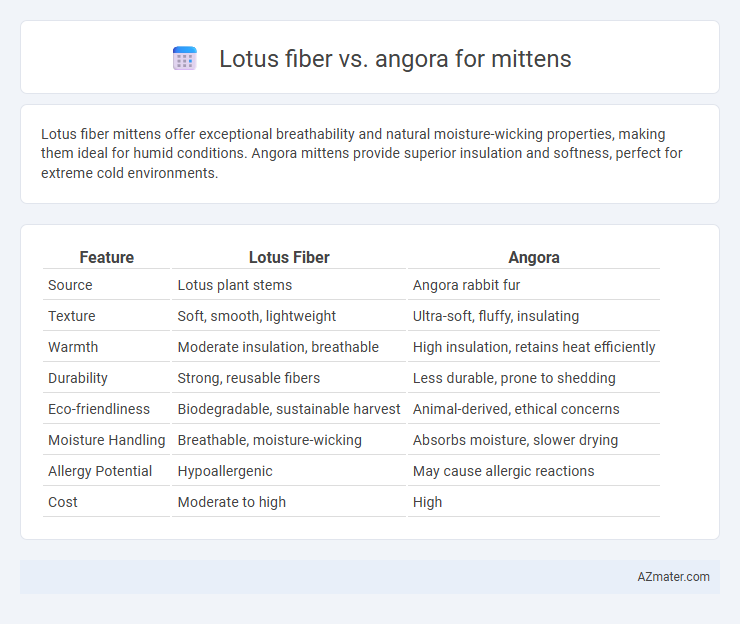Lotus fiber mittens offer exceptional breathability and natural moisture-wicking properties, making them ideal for humid conditions. Angora mittens provide superior insulation and softness, perfect for extreme cold environments.
Table of Comparison
| Feature | Lotus Fiber | Angora |
|---|---|---|
| Source | Lotus plant stems | Angora rabbit fur |
| Texture | Soft, smooth, lightweight | Ultra-soft, fluffy, insulating |
| Warmth | Moderate insulation, breathable | High insulation, retains heat efficiently |
| Durability | Strong, reusable fibers | Less durable, prone to shedding |
| Eco-friendliness | Biodegradable, sustainable harvest | Animal-derived, ethical concerns |
| Moisture Handling | Breathable, moisture-wicking | Absorbs moisture, slower drying |
| Allergy Potential | Hypoallergenic | May cause allergic reactions |
| Cost | Moderate to high | High |
Introduction to Lotus Fiber and Angora
Lotus fiber, derived from the stalks of lotus plants, is a rare and sustainable natural textile known for its lightweight, breathable, and moisture-wicking properties, making it an innovative choice for mittens. Angora wool, harvested from Angora rabbits, offers exceptional softness, warmth, and elasticity, prized for luxurious and cozy mitten construction. Both fibers present unique qualities, with lotus fiber providing an eco-friendly, plant-based option and Angora delivering superior insulation and plush texture.
Origins and Production Processes
Lotus fiber, derived from the stalks of lotus plants in regions like Myanmar and Thailand, undergoes a labor-intensive extraction process involving soaking, hand-stripping, and spinning into delicate threads. Angora fiber, sourced from Angora rabbits primarily in China and France, is harvested through shearing or plucking during molting seasons, ensuring a soft, lightweight, and insulating material. The distinct origins and artisanal production methods of lotus fiber and angora contribute uniquely to the texture and thermal properties of mittens made from these fibers.
Texture and Softness Comparison
Lotus fiber mittens offer a unique combination of natural breathability and a slightly coarse texture, making them durable yet less plush compared to Angora. Angora mittens are renowned for their exceptional softness and silky texture, providing superior warmth and a luxurious feel ideal for sensitive skin. The contrasting tactile qualities highlight Lotus fiber's strength and eco-friendliness versus Angora's smoothness and premium softness.
Warmth and Insulation Properties
Lotus fiber offers moderate warmth and breathable insulation, making it suitable for mild to cool weather mittens, but it is less effective in extreme cold. Angora fiber, derived from Angora rabbits, provides exceptional warmth and superior insulation due to its hollow core structure, trapping heat efficiently. Mittens made from Angora are ideal for retaining heat in harsh winter conditions, while Lotus fiber is better for lightweight, eco-friendly options with moderate thermal protection.
Durability and Longevity
Lotus fiber mittens offer exceptional durability due to their natural strength and resistance to wear, making them ideal for long-term use in harsh conditions. Angora mittens provide unparalleled softness but tend to be less durable, as the fine fibers can wear down more quickly with frequent use. Choosing lotus fiber enhances longevity and maintains structural integrity better than angora in cold-weather accessories.
Hypoallergenic Qualities
Lotus fiber mittens are highly valued for their natural hypoallergenic properties, making them ideal for sensitive skin and allergy sufferers. Angora wool, while exceptionally soft and warm, can cause irritation or allergic reactions due to lanolin content and fine hair fibers. Choosing lotus fiber ensures breathable, irritation-free warmth, especially suitable for those prone to eczema or allergic dermatitis.
Eco-Friendliness and Sustainability
Lotus fiber, derived from the lotus plant, offers exceptional eco-friendliness due to its renewable sourcing and minimal water usage during cultivation, making it a sustainable alternative to animal-based fibers. Angora, harvested from Angora rabbits, involves ethical concerns and intensive animal care, which can impact sustainability and raise animal welfare issues. For mittens, choosing lotus fiber supports biodegradable, cruelty-free production with a lower environmental footprint compared to the resource-intensive and ethically debated Angora wool.
Care and Maintenance Requirements
Lotus fiber mittens require gentle hand washing with mild detergent and air drying to maintain their natural softness and durability, avoiding harsh chemicals that can damage the plant-based fibers. Angora mittens demand careful handling to prevent felting and shedding, necessitating cold water washes, gentle detergents specifically for wool, and flat drying to preserve the delicate rabbit hair. Both materials benefit from regular airing and storage in breathable bags to prevent moisture build-up and maintain their structural integrity over time.
Cost and Accessibility
Lotus fiber mittens are generally more expensive due to the labor-intensive process of extracting and spinning the natural, eco-friendly fiber, which remains relatively rare and limited in availability. Angora mittens tend to be more accessible and moderately priced since Angora wool is more widely farmed and commercially produced, providing a broader range of products at different price points. Cost efficiency and accessibility make Angora a practical choice for everyday mittens, while Lotus fiber suits niche markets prioritizing sustainability and exclusivity.
Best Choice for Mittens: Final Verdict
Lotus fiber offers exceptional breathability and sustainability, making it an eco-friendly option for mittens that stay comfortable in varying temperatures. Angora, prized for its superior softness and unparalleled warmth, provides luxurious insulation ideal for cold weather conditions. For mittens, angora remains the best choice due to its thermal properties and plush texture, while lotus fiber suits those seeking lightweight, natural alternatives.

Infographic: Lotus fiber vs Angora for Mittens
 azmater.com
azmater.com